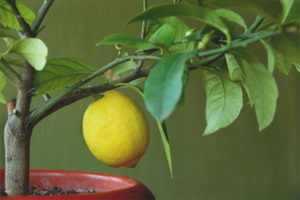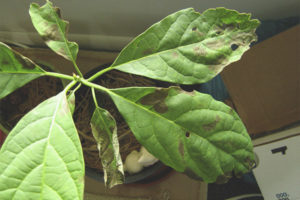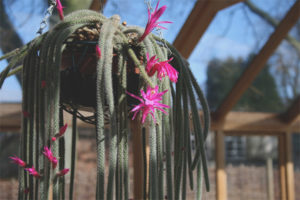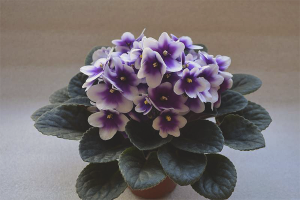The content of the article
Vallota is a flower of South American origin, and it owes its name to the French naturalist Pierre Vallo. The plant belongs to the Amaryllis family and is distinguished from the family by the fact that:
- Sheet plate has a purple-green color.
- A small oval bulb, representing the root system, is covered with scales of light crimson color.
- The budding of daughter onions occurs due to the repulsive legs, so they come to the surface, and as they grow, a root ending is formed, which draws the bulbs into the ground. In other species, children ripen in the depths of the earthy coma.
Vallota flowers are on a long peduncle, which has no sepals, and they are collected in the "umbrella". Usually it is possible to count from 3 to 9 flowers on a plant. Depending on the variety, they are bright red, and pale pink, and orange.The leaves resemble the shape of a sword, and their dark green color at the petiole turns purple.
It should be remembered that this plant is considered poisonous.
How does a plant tolerate heat and cold?
It is easy to take care of the shafts, it grows quickly and is a strong and stable plant.
Since her homeland is located in a warm climate zone, Vallot loves a fever. Therefore, it is necessary for the plant to create a cozy environment with bright light and warmth. But on the hottest days of his day should be protected from too intense sun. If the air temperature exceeds 25 degrees Celsius, it is better to remove the plant from the window sill during the day. On such days it will be necessary to irrigate it from special devices, but make sure that no moisture drops fall on the petals of the flowers - this may harm their surface.
The leaves should be kept clean by wiping them with a soft sponge or damp cotton cloth. If in a hot time the plant is not hidden from the sun and watered, it can remain burns on the leaves.
In winter, the room in which the vallotte is kept,should be cool - no higher than 12 degrees. The main thing is that the plant does not experience sudden temperature changes and does not fall under the draft. Observing these simple rules, it is possible to achieve more abundant flowering, since then the plant hibernates and during this time it accumulates strength to be active in the warm season.
Important! If the room temperature is below 8 degrees Celsius, the roots can freeze, and then the plant will completely die.
Watering
Watering the wallot as well as other bulbous plants, therefore, avoiding excessive waterlogging of the soil.
When active growth occurs, watering is required only after the topsoil has dried out thoroughly. In cold weather, especially from January to April, when the plant is at rest, the lower the temperature, the less often it is necessary to water it. Some gardeners believe that at this time should not be watered at all. The surest way to determine the wrong watering - vallota begins to lose leaves. In this case, the mode needs to be urgently changed.
When spring comes, new leaves will begin to appear, the plant will need strength to grow, which means that watering should increase.During the growing season after water treatment, if there is water left in the pallet, it must be removed, as the vallotte is one of those species that are less likely to receive less water than to be overmoistened. Between irrigation, the soil should dry out more than 70 percent.
The intervals between successive irrigations entirely depend on the season and the conditions in which the flower is contained. In the summer, watering should occur twice in 7 days, the winter period dictates a different schedule - about once every 15 days.
Top dressing
Required plant nutrition. It will be useful from spring to the final autumn flowering. But again, the opinions of experts are different: some believe that it is necessary to add fertilizer, although rarely, but still, despite the sleeping state of the plant.
You can purchase ready-made complex fertilizer, rich in essential minerals, for flowering houseplants or bulbous. In order for the plant to develop, mineral fertilizers alternate with organic.
At home, you can prepare your own nutritional soil. For this you will need:
- sod land - 3 parts, deciduous - 1 part;
- sand, preferably river, - 1 part;
- humus - 1 part;
- bone meal - 1 part.
Add a small amount of mullein and peat to the mixture if desired. Make the feeding should not more often every 14 - 20 days. Drainage is required.
Transfer
Very sensitive plant reacts to transplant, even if the new soil is better than before. The root system of the walotta is very sensitive, and therefore the irreversible process of decay can begin. Therefore, flower growers are advised to repot the flower only when the grown plant needs more space. If the pot is too narrow, the parent bulb produces more vigorously, and then pushes the daughter bulbs out. But they are too depleting the main bulb, because it is desirable to separate them as soon as possible.
At the new site, part of the maternal bulb is not buried: “kids” will appear over time. The wider the new capacity, the more the plant will grow in breadth, becoming much thicker.
In the first few years, the plant is trying not to replant, but since the earth is depleted, it will still be time to replant. This procedure is carried out in 3 - 5 years.
How does reproduction occur
Caring and proper care gives positive results, and the bulb of vallota produces peduncles. Most often, this pleasant event occurs twice during the season, 2 - 3 buds can unfold at once. The life of the stem with flowers is less than a week. After that, no need to rush to pick off the spike. It is necessary to wait until it dries thoroughly, and only then carefully cut it very short.
Reproduction occurs:
- Seeds. The most time-consuming process, because in the home is rarely used. It will be necessary to sow the seeds in the autumn, moistening the soil and closing it with glass. It will be necessary to ventilate the soil, observing the temperature regime of 16 - 18 degrees. In a month sprouts will start to appear. The first dive should be done when the seedlings are 6 months old, while planting the bulbs are fully immersed in the ground, and after two years, during transplanting, the upper part should remain outside. Flowering will begin in 3 years.
- Child bulbs. In this case, the flower begins in 1 - 2 years. The main onion provides affiliated onions, which remains to be separated and planted, deepening in half, in separate pots with a substrate. They usually take root quickly and grow well.Watering should be done not very often, especially this rule applies to the first months.
- From the bulb, cut into 4 parts. They are planted in the substrate, and grown as subsidiaries.
What can harm the plant?
Since the vallota does not tolerate an increased level of moisture, with improper care, it begins to suffer from a disease like gray mold. In such a soil, various pests appear that are also destructive for a delicate plant. That is why it should be planted in the soil, which was decontaminated. This is especially important for young bulbs.
Most often strikes a wallot:
- Spider mite You can identify it by visible traces - the pest braids the plant with a thin web and leaves white dots.
- Aphid. It multiplies very quickly, creating numerous colonies and migrating, attacking other plants. Loves juice especially young leaves. After the aphids stay, the leaf plate is twisted, the plant may die.
- Shchitovka. Having settled on a plant, it can drink all the juice and destroy it. It leaves a sticky liquid on which a black fungus develops.
- Thrips. Dangerous pests, can hide in flowers and buds.
- Mealybugs Looks like small bumps, and on the leaves because of them there is a specific white cotton wool.
- Fusarium - destroys, above all, the roots, especially if the plant is young.
From each category of pests and diseases there are a variety of chemical agents that are sold in specialty stores.











To send